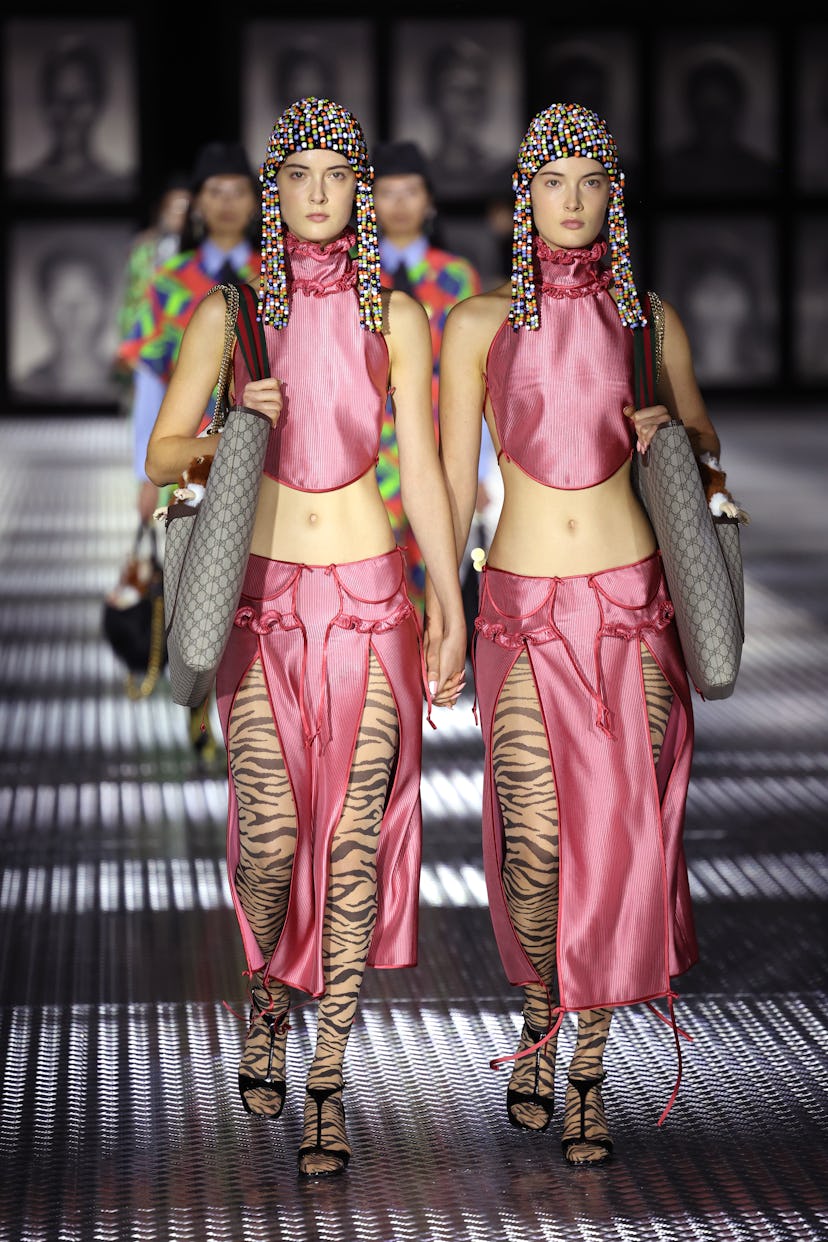Gucci Explores the Individuality of Duality

Gucci’s Twinburg’s show at Milan Fashion Week opened with Mary-Kate and Ashley Olsen’s Identical Twins lyrics read by Marianne Faithfull, her wise, poetic voice booming over the speakers: “We’re twins, we’re twins, yes sir. I am me, she is she, except when I pretend I’m her. And when we switch, you can’t tell which is which. You don’t know who you’re talking to, because we’re identical, ‘dentical, ‘dentical, identical twins!”
But even that intro wasn’t the biggest shock of the show, which began with models walking down the runway alone—before each one was joined for a second walk with their identical twin, evoking the feeling of an additional show altogether. Seeing each look at first in the traditional runway format, then witnessing it once again with an exact copy—styled and replicated the same—created a thought-provoking effect. Creative director Alessandro Michele said he was inspired by the intimate twinship of his own mother and her twin. But the meaning here went much deeper, playing with the idea of originals and copies. What does it mean when style is multiplied, and how does individualism impact identity, perception, and even self-expression?
The collection itself was composed of a mix of Michele’s greatest hits, plus, what felt like a return to the eccentric magpie love of accessories and ornate decoration that is so connected to Michele’s earliest collections for Gucci (the last few seasons, it felt like jewelry took a backseat). Spring 2023 was purely a celebration of individuality. Beaded headpieces, pearl earrings that extended more than one-foot long, bows, animal print gloves, glasses swinging with chains, and metal face jewelry all dripped off each identical body in unison.
Photos by Daniele Venturelli/Getty Images for Gucci
There were even fluffy versions of Gizmo from Gremlins hanging off of belts, on fluffy bags, and printed on the bottom of two column-style gowns. Dark humor punctuated the collection, with the serious Olsen twins reading and the somewhat macabre adornments. Oversized flaming sequin jackets read “fuori” (“out” in Italian).
Tailored blazers, leather jackets, pinstriped suits, and sporty leather logo coats played at the understated side of duality—slightly off-kilter effects were there too, like suits broken up with garter straps and visible thongs. The pleated gold blouses, overalls, glittering animal print dresses with matching beanies, and gloves attached and sequined jackets represented a version of unadulterated opposites.
“The same clothes emanate different qualities on seemingly identical bodies,” Michele wrote in the show notes. “Fashion, after all, lives on serial multiplications that don’t hamper the most genuine expression of every possible individuality.” This was all true. But one couldn’t help but wonder, with such an endearing expression that really got to the love of self-expression and individualistic representation, where were the body diverse twins? There were 68 sets of twins, and all of them resembled the traditional model ideal.
Still, as the twinsets walked down the runway holding hands, each of their nails matching and painted with dual colors, it was a powerful sight that made even the wildest and most overly produced shows feel bland in comparison. The message of identity and otherness—doubleness, if you will—is quite the thought starter when contextualized in fashion; especially given the times in which we’re living.